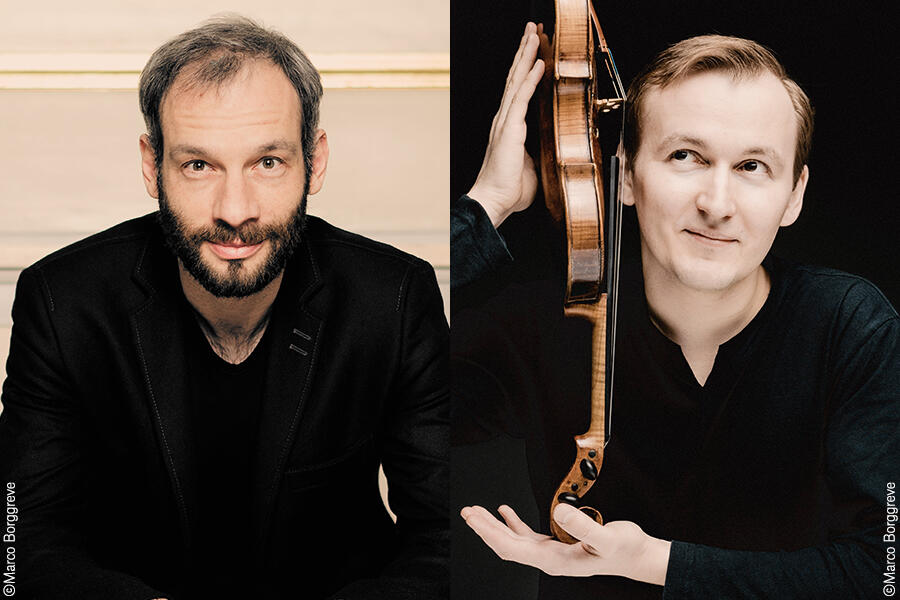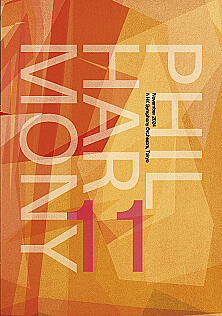- Home
- Concerts
- Subscription Concerts 2024-2025
- Program B
- No. 2024 Subscription (Program B)
No. 2024 Subscription (Program B)

Program
Tchaikovsky / Violin Concerto D Major Op. 35
For Peter Ilich Tchaikovsky (1840–1893), a Romantic composer representative of Imperial Russia, the year 1877 was a watershed both in his personal and professional lives. During this year, his painful married life which lasted for a mere two months plunged him into a nervous breakdown, whilst the lucky composer started to receive regular allowance from his wealthy patroness Nadezhda von Meck. Thanks to this financial support, Tchaikovsky was able to leave Russia in October 1877 to convalesce in Italy and Switzerland. Regaining his creative motivation there, he completed the Symphony No. 4 and dedicated it to Madame von Meck in token of gratitude.
This prolonged European stay also gave birth to the Violin Concerto, another masterwork of Tchaikovsky. A stimulus to the composition—he wrote it in a month in 1878—was the Spanish Symphony (1874) by the French composer Lalo: the Russian man discovered this violin concerto full of exoticism through his pupil Iosif Kotek while staying in Switzerland. And hence, Tchaikovsky’s concerto is rich with folkloric inspirations, as in the case of the opening movement’s principal theme first sung by the solo violinist. Following the slow second movement of which the title Canzonetta (meaning “little song” in Italian) evokes Tchaikovsky’s stay in Italy, the last rondo movement begins without break. The soloist introduces the brisk rondo (recurrent) theme based on trepak, a Russian peasant dance, which will bring this virtuosic finale to a splendid close.
[Kumiko Nishi]
Prokofiev / The Tale of Stone Flower, ballet―The Mistress of the Copper Mountain, Wedding Suite
Sergei Prokofiev (1891–1953) was born in Imperial Russia (today in Donetsk Oblast, Ukraine) in the last decade of the 19th century. Following the 1917 Revolution, unlike Rachmaninov who exiled himself nor Shostakovich who remained in the Soviet Union, Prokofiev left his home in 1918 by permission of the Soviet authorities to compose and perform overseas. In 1936, he returned for good to the Stalinist USSR offering to the composer some carrots of fame and opportunities. He led a difficult life particularly after the Communist Party increased their censorship in 1948, which forced him to pursue a career as a composer toning his modernist tendency down.
The Tale of Stone Flower (1948–1953) is Prokofiev’s last ballet score completed right before his passing. Based on an Ural folk tale, the plot is set in a mining community. The leading role Danila, a stone carver, aspires to create a malachite vase as beautiful as a living flower. For this ultimate goal, he goes down to the underground realm. A part of the ballet’s Prologue, The Mistress of the Copper Mountain is entitled so after the realm’s ruler with a supernatural power: at the outset, trumpets give the metallic, mysterious melody in unison. Wedding Suite was prepared as a concert piece by Prokofiev prior to the ballet’s premiere. The five movements are derived from the scenes of Act I where the community delightfully celebrates Danila’s engagement to lovely Katerina.
[Kumiko Nishi]
Stravinsky / Symphony in Three Movements
A pupil of Rimsky-Korsakov in Saint Petersburg, the Russian-born composer Igor Stravinsky (1882–1971) produced a great sensation in 1913 in Paris with his primitivistic music for the modern ballet, The Rite of Spring. His fate following the fall of Imperial Russia was as peculiar as Prokofiev’s, for Stravinsky had been obliged to settle down in Switzerland at the outbreak of World War I and, when the 1917 Revolution occurred, he learned abroad that his property in his homeland was confiscated by the Bolsheviks. After he spent two decades in France, the outbreak of World War II made him decide to settle in the USA in 1939.
From his American period, the Symphony in Three Movements was composed in 1942–1945 for the New York Philharmonic. It was premiered by Stravinsky conducting the orchestra in January 1946, immediately after he took US citizenship. The work is regarded as his final statement of musical neo-classicism, the movement he originated in 1920 to revive styles and aesthetics of the past in modern light. On the other hand, powerfully savage rhythms and accents of the outer movements evoke Stravinsky’s above-mentioned primitivism: it is suggestive that he revisited The Rite of Spring to largely revise its final Sacrificial Dance in 1943. The first movement of the Symphony was originally conceived as a concerto for piano, whilst the second movement spotlights a harp. As if joining the previous movements, the finale gives prominence to both piano and harp.
[Kumiko Nishi]
[Encore]
November 21: J.S.Bach / Partita for solo violin No.2 in D Minor, BWV 1004 – Sarabande
November 22: Ernst / Grand Caprice for solo violin on Erlkönig Op. 26
violin: Nikita Boriso-Glebsky
Artists
 ConductorDima Slobodeniouk
ConductorDima Slobodeniouk
Finnish conductor Dima Slobodeniouk, who was born in Moscow in 1975, is active worldwide as one of the most notable conductors of his generation.
Dima Slobodeniouk studied with the Ukrainian violinist Olga Parkhomenko at Helsinki’s Sibelius Academy, where he graduated in 2001. It was there that he also took up his conducting studies with Leif Segerstam, Jorma Panula and Atso Almila and also pursued further studies under Ilya Musin and Esa-Pekka Salonen.
From 2013 to 2022, he served as Music Director of the Orquesta Sinfónica de Galicia (Spain), and from 2016 to 2021, he was Principal Conductor of the Lahti Symphony Orchestra (Finland) and Artistic Director of the Lahti Sibelius Festival. He has also been invited by world’s renowned orchestras such as the Berliner Philharmoniker, the Gewandhausorchester Leipzig, the Symphonieorchester des Bayerischen Rundfunks, and the Royal Concertgebouw Orchestra, and has been received very favorably.
Dima Slobodeniouk has garnered international acclaim for his diverse and dynamic repertoire, which includes not only Russian and Scandinavian works but also numerous contemporary compositions. His first collaboration with the NHK Symphony Orchestra dates back to July 2019 when he conducted the orchestra’s summer concert, but this is his first appearance for the subscription concerts.
[Ryosuke Masuda, music critic]
 ViolinNikita Boriso-Glebsky
ViolinNikita Boriso-Glebsky
Nikita Boriso-Glebsky, born in Russia in 1985, is one of today’s top artists who has continued to expand his span of music by never stopping to pursue further studies even after winning numerous international competitions, including those of Tchaikovsky (Moscow), the Queen Elisabeth (Brussels), Fritz Kreisler (Vienna), Sibelius (Helsinki), Montreal, and Monte Carlo. After studying with tutors including Eduardo Grach at the Moscow Conservatory, he also studied with Augustin Dumay at the Chapelle Musicale Reine Elisabeth in Belgium, and with Ana Chumachenco at the Kronberg Academy in Germany.
While performing masterpieces to entice audiences, he also made recordings of hidden works by Ysaÿe and Medtner. In recent years, he was invited to the Wiener Konzerthaus as its artist-in-residence, and performed Beethoven’s complete string quartets at the Suntory Hall Chamber Music Garden as the first violin of the Atrium Strings Quartet.
He first worked with the NHK Symphony Orchestra in July 2017 playing Tchaikovsky Violin Concerto, then Glazunov’s Concerto in the December 2019 subscription Program C concert.
[Yoshimichi Okuda, music critic]
Download
Ticket
Program B
No. 2024 Subscription (Program B)
Suntory Hall
Google Map
Seating Chart
Single Tickets Release Date
Pre-sales for Subscribers:Wednesday, July 31, 2024
*about subscribers
Sale to General Public:Sunday, August 4, 2024
Price
| S | A | B | C | D | |
|---|---|---|---|---|---|
| Ordinary Ticket | 12,000 | 10,000 | 8,000 | 6,500 | 5,500 |
| Youth Ticket | 6,000 | 5,000 | 4,000 | 3,250 | 2,750 |
Seating chart Enlarge Print PDF
*tax included
*Subscribers receive a 10% discount (Available at NHKSO WEB Ticket and N-Kyo Guide)
*For wheelchair-accessible seats, please refer to the N-Kyo Guide
Youth Tickets
Youth Tickets are great options for those of 29 years old and younger
Subscription tickets
Release Date
ANNUAL SUBSCRIPTION TICKETS
Mon., July 15, 2024 10:00am
[For Subscribers: Sun., July 7, 2024 10:00am]
Where to buy
NHKSO WEB Ticket | Thursday, November 21 (In English / Seats not selectable)
NHKSO WEB Ticket | Friday, November 22 (In English / Seats not selectable)
NHKSO WEB Ticket (In Japanese only / Seats selectable)
N-Kyo Guide (Purchase by telephone only)
*Repertoire, conductor, soloists and program order are subject to change without notice.
*Pre-school children are not allowed in the concert hall



